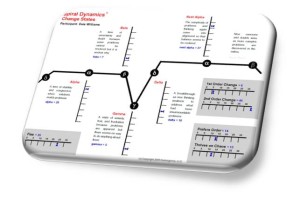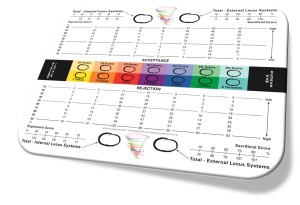Spiral Dynamics® Assessment Suite
IMPORTANT NOTE: Because they require a knowledgeable administrator to avoid misuse and misinterpretation, we only make these assessments available to people who have successfully completed at the least our Spiral Dynamics Level 1 training (see our training section).
Measuring the “Levels of Human Existence” is notoriously difficult. Most attempts get at what people like to think about or how they want to be perceived, not how they actually process and relate. To report numbers and project motives into a color code is easy, sometimes satisfying. But knowledgeably interpreting what those scores might mean is a different story. Effective interpretation requires a good grounding in the theory, as well as a clear understanding of what data from instruments like these can and cannot reveal.
We further advise administrators to know and abide by the legal requirements of their home countries, as well as to general ethical principles for assessment. We will collaborate and support legitimate academic studies by trained users with certain restrictions.
These tools are copyrighted by National Values Center Consulting and all rights are reserved—authorization for use is available from NVCC. These indicators can be useful in many areas: consultants (OD, strategy, change management, etc.), coaches, facilitators, trainers, communications designers, and educators all apply them in various ways. Because the theory is about human nature in operation, the assessments can be useful in almost any domain where people factors matter. Inquire about registering for training to learn about opportunities to gain access to these tools.
The Spiral Dynamics Change State Indicator
A Spiral Dynamics Assessment of the Change Journey

CSI Profile Sheet
The Spiral Dynamics Change State Indicator (CSI) is easily administered online. Like the VPII, it is available for a one-year trial period to NVCC-trained SD Level 1 practitioners, and on a permanent basis to SD Level 2 and above practitioners via NVCC’s proprietary Spiral Dynamics Spiral Survey System. Consisting of 30 questions designed to measure change readiness and preferences, it suggests the degree of ease or resistance individuals, work groups, and teams might experience during a change process. It also gives a good indication of stress and can point to a direction of systems change when used in conjunction with the VPII or Discover (below).
Description: The Change State Indicator (CSI) is a versatile tool with a total of ten scales. Five of these scales evaluate travel along the “states of change” experienced by people as they either migrate from one Gravesian Human Psychosocial System to another or move from stability through uncertainty and turbulence and back to a new kind of stability on some aspect of living. Other scales address preferences for kinds of change, order and chaos, and the perceived ease or difficulty of changing.
These findings translate into a variety of workplace behaviors and preferences impacting group cohesion, management, culture, ability to innovate and learn, forms of communication, training and support needs, leadership preferences, strategy implementation, etc. Understanding these dynamics can be crucial in a coaching intervention. It is a good indicator of degrees of stress, as well as a useful tool for figuring out what kind of change will be appropriate for an intervention.
Examples Of Spiral Dynamics Change State Indicator Applications: As a training tool to convey the change model as taught in Spiral Dynamics Levels 1 & 2, Practicum, and SDL3; as a coaching guide for executive coaches to better understand client needs; as a team-building instrument to identify and discuss problems and conflicts during restructuring; as an organizational development approach for more congruent change initiatives; to understand how stress is impacting individuals and groups; to plan a best fit approach to change for an individual, group or team; for personal development, insight and understanding; building change resilient teams, and more …
Time Required For Completion: 15-20 minutes. Internet connection needed. Browser must be set to accept cookies, though no personal information is harvested other than the stated demographic questions.
The Spiral Dynamics Discover
A Spiral Dynamics Assessment of Levels of Human Existence
The Discover (DSC) is easily administered in an online format. It is available to NVCC-certified and trained Spiral Dynamics Level 2 and above practitioners. Consisting of 40 statement clusters and 10 open item stems which serve as an internal validation, DSC is designed to evaluate overall systems in Gravesian thinking and coping preferences in a broad context. It does not purport to measure the eighth system, Turquoise in the color code, making it somewhat less susceptible to certain types of skewing, but also missing a data set that is important to some clients, not to others.

Discover Profile Sheet
Description: The Discover instrument is suited for use with individuals, work groups, teams and larger organizational/culture studies.
It consists of 12 scales – six “most like me” and six “least like me” dimensions. The format requires making two choices from clusters of 4 or 6 statements. These indicate individual preferences for six worldviews (Psychosocial Systems) patterns in the Spiral model. The six Systems are descriptions of how people see their worlds: their preferences for particular work environments, reward systems, career priorities, ways of behaving and interacting. The six worldviews measured are based in Clare W. Graves’s Levels of Existence Theory and the dimensions consist of: Tribalistic, Egocentric, Absolutistic, Multiplistic, Interpersonalistic, and Systemic systems.
These dimensions translate into a variety of workplace behaviors and preferences impacting group cohesion, conflict and collaboration, management approaches, engagement and retention, organizational cultures, leadership styles, reward and leader preferences, motivation strategies, effective communication, interpersonal relationships, and sensitivity to various change, strategic, and organizational development approaches.
Examples Of Spiral Dynamics Discover (DSC) Applications: As a training tool to explain the Value Systems in the Spiral model taught in Spiral Dynamics Level 1 & 2 training; as a coaching aid for executive coaches to align to client needs and goals; as a team-building instrument to foster understanding and collaboration; for insight into work group dynamics and the roots of interpersonal conflict; for personal growth, development, insight and understanding of others; to understand how differences in worldviews impact human affairs; in building greater awareness of human variability …
Time Required For Completion: 30-60 minutes. Internet connection needed. Set browser to accept cookies.
The Values Profile II (VPII)
A Spiral Dynamics Assessment of Gravesian Psychosocial Systems

VPII Profile (raw)
Formerly called The Values Test, the updated Spiral Dynamics Values Profile II (VPII) is easily administered online. The VPII is available for a one-year trial period to NVCC-trained SD Level 1 practitioners, and on a permanent basis to SDLevel 2 practitioners and above. Consisting of 10 statement clusters designed to evaluate worldviews and valuing system preferences, this popular Spiral Dynamics tool is used around the world and available in many languages including English, French, Spanish, Dutch, German, Russian, and Italian versions via NVCC’s proprietary Spiral Dynamics Spiral Survey System.
Description: The SD VPII enhances self-understanding in business, educational, and personal development settings. It is often used in training and education, as well as coaching and can be applied in strategy and marketing, as well. VPII results appear in a profile of 14 scales – seven “acceptance” and seven “rejection” components which represent individual preferences for seven worldviews and psychosocial systems. Participants allocate points among completions, meaning some simple arithmetic is involved. Cumulative data cuts can indicate group, team, and organization-wide preferences. These Coping Systems are filters through which people think and conceptualize the worlds: their preferences for work environments, reward systems, personal priorities, perceived strengths and weakness.

VPII Profile (comparative)
The seven worldviews measured in VPII are based in Clare W. Graves’s Levels of Existence research and consist of the following dimensions: Tribalistic, Egocentric, Absolutistic, Multiplistic, Interpersonalistic, Systemic, and Holistic. These dimensions translate into a variety of preferences impacting behavior in terms of group cohesion, conflict and collaboration, management approaches, organizational culture, leadership style, reward and leadership preferences, motivation (and de-motivation) strategies, preferred forms of communication, etc.
Examples Of Spiral Dynamics Values Profile II Uses: As a training tool to convey the Spiral model taught in Spiral Dynamics Level 1 & 2 training for specific applications As a coaching aid for executive coaches to align to client needs/outcomes As a team-building tool to identify interpersonal conflict & confluence As a gauge for establishing organizational culture and norms As a basis for personal development, insight and understanding of others To understand how differences in worldviews impact cultures in collision Enhancing recognition of deeper needs and motives, and more …
Time Required For Completion: 45-60 minutes. Internet connection needed. Set browser to accept cookies.
For More Information Contact:
The National Values Center Consulting (NVCC)
P.O. Box 40110
Santa Barbara, CA 93140
TEL: (805) 962 – 0366 FAX: (805) 962 – 0306
info@spiraldynamics.org
For More Information...
Fill out the form below to learn more about our programs.
